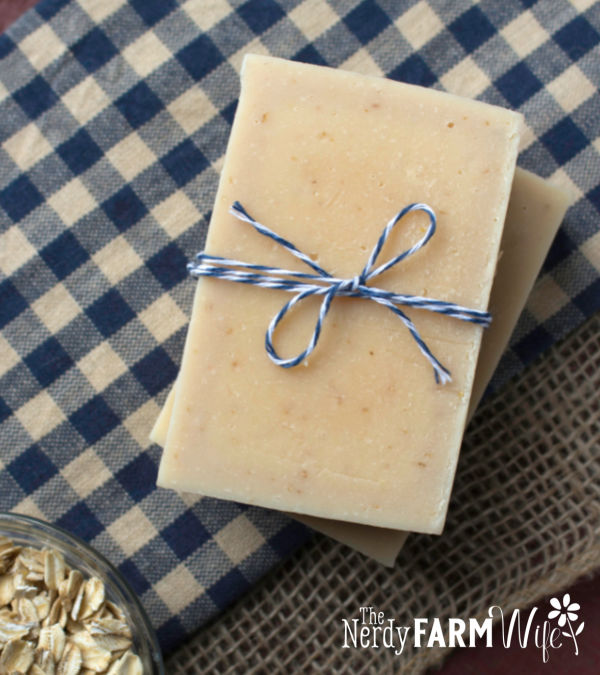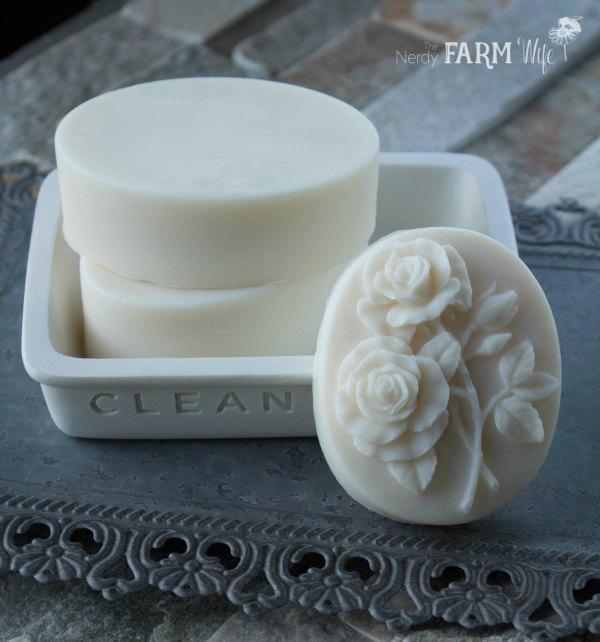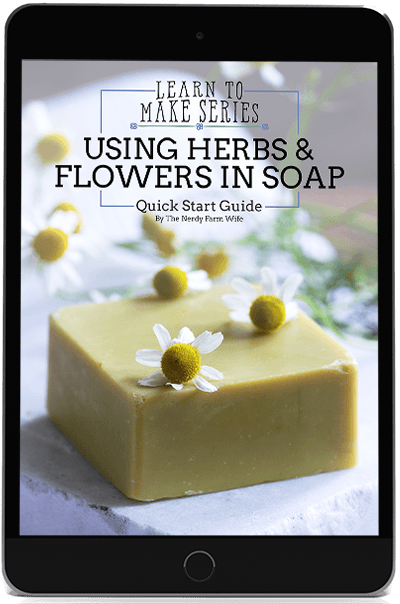5 Tips for Making Soaps for Eczema + Recipes
Learn how to make natural cold process soaps for eczema, plus plenty of recipes to get you started!
I’m often asked about making homemade soaps for eczema. As someone with severe childhood eczema, who grew up to have a son with severe eczema, I’ve got some experience with this topic!
While there are many primary factors contributing to eczema, such as genetics, allergies, and diet, what you put on your skin can absolutely help make a difference.
Homemade soap is a great choice for those with eczema (atopic dermatitis), and sensitive skin. The soapmaking process naturally creates glycerin which is great for your skin, but is usually removed from commercial soaps and sold as a separate byproduct. You can also avoid potentially problematic detergents, and personalize the recipes to avoid any allergens.
Before I started making soap for my son, he had horrible skin that his pediatrician always commented on, only to recommended prescription creams. (They didn’t help.) After he had been using my homemade soap for many months, we went back for a well-child visit and the doctor kept rubbing his arm and remarking upon his beautiful skin! ❤
5 Tips for Making Eczema Soaps
Here are some helpful tips to remember when formulating natural soap for eczema, followed by several recipe suggestions.
1. Check the amount of cleansing oils in your recipes.
Some oils, specifically coconut, babassu, and palm kernel oil, are very effective cleansers when turned into soap. They also help add great lather and bubbles.
Unfortunately for people with dry or sensitive skin, those ingredients in soap can clean too aggressively, stripping the moisture from your skin and leaving it open to an eczema flareup. If you have eczema, try to use a smaller amount of those oils (some prefer as low as 10 or 15%) and/or pair those lower amounts with a higher superfat (see #2 below), or completely leave coconut oil out of your recipe.
2. Adjust the superfat level of your recipe.
The superfat amount = the amount of extra oils in your recipe that won’t turn into soap. In the case of dry skin, it’s often helpful to have a somewhat higher superfat in your handmade soap. You may find that a 7 or even 8% superfat works best for your skin.
There is a drawback to a higher superfat though; you may notice that the lather is slightly diminished and more creamy, than if you used a lower superfat. If you’ve ever had eczema symptoms however, you know that sufferers normally don’t worry about a small bit of lather change during a flare up, as much as we worry about getting relief!
3. Know common eczema triggers.
A few ingredients that may act as irritants and cause trouble for some, but certainly not all, of those with ultra sensitive skin include: coconut oil, cocoa butter, lanolin, aloe, milk, and/or essential oils such as lemongrass, bay rum, cinnamon, or clove.
On the other hand, some eczema sufferers do extremely well with goat milk soap, so don’t rule out using milk altogether, just be aware that not everyone will benefit from it. (Myself included, likely because I also had a childhood allergy to milk.)
4. Avoid fragrance oils, minimize or eliminate essential oils.
Allergies to fragrance oil is common in eczema sufferers, so heavily fragranced soaps should be avoided. If you do choose to add essential oils, stick with basics such as tea tree and lavender essential oil and add them in low amounts. Even though they’re naturally sourced products, those with super sensitive skin and systems may not be able to tolerate them, so it’s often best to leave your soap unscented.
Also watch out if you purchase inexpensive “essential oils” from places such as Amazon. Most of those are mislabeled synthetic oils that will not only potentially irritate your skin, but can also cause lots of problems with your soap when you mix them in. (I get many emails and comments, related to this problem!)
5. Avoid scratchy or drying additives.
While clays are wonderful and can add a pretty color to your soap, they can also feel drying, especially if you’re already prone to eczema or dry skin. In the same manner, avoid exfoliants such as coffee grounds, cornmeal, loofah, pumice, etc, that may scratch or irritate the delicate skin barrier.
In summary, often the simplest and most basic fragrance-free soap can be best for eczema!
Recipes: Natural Soaps for Eczema
Here are some of my favorite homemade soap recipes to consider if you’re prone to eczema, itching, or have super sensitive skin.
If you’ve never made cold process soap before, be sure to study the craft first. To learn how to make homemade soap step by step, check out my article, Soap Making 101, and my popular Handmade Natural Soaps eBook Collection is filled to the brim with helpful information and recipes.
Proper curing of your soap bars is also essential. Even if you make hot process soap, it must cure a minimum of 4 to 6 weeks, and the soap will become even milder as it ages.
Mild Unscented Soap Recipes {for sensitive skin} – This article contains two extra gentle soap recipes that can be used for those with sensitive skin, eczema, or allergies: Extra Gentle Unscented Soap with Aloe Vera Recipe and Creamy Shea Butter Unscented Bastille Soap Recipe.
Chamomile “Almost Castile” Soap – This soap formula retains the mildness of olive oil castile soap, but also includes castor oil to boost the lather. I infused this recipe with the skin-soothing herb chamomile, but you could use calendula instead, or even leave out the herbal infusion completely if you’re allergic to chamomile, or don’t want to include herbs.
Oatmeal & Honey Soap Recipe – A classic favorite filled with soothing ingredients – oatmeal soap is good for eczema and itching skin!
We use gluten free oats to make ours, but you can use regular oats just as well. Oatmeal soap is good for eczema and other itchy skin conditions, and here we combine it with honey which is nourishing/healing for skin, and also contributes to a boost in lather. (Can’t use honey? Try agave nectar instead, or just leave it out.) This recipe is cold process, I also have a similar hot process version: How to Make Oatmeal Honey Soap in a CrockPot.
Healing Skin Bar – (Scroll down to the second recipe in that article.) This is a variation of the first soaps I made for my son’s eczema. Each time I made it, I loaded the water portion with herbs and flowers and anything I had on hand that helped reduce inflammation or soothe irritated skin. Many times, especially in the early days, I made the soap without any essential oils, then in later years added them in. You could easily leave out the essential oils if you’d like.
Aleppo Style Soap – This gentle soap is made with just four ingredients: olive oil, laurel berry fruit oil, water, and lye. It’s inspired by an ancient Syrian recipe and beneficial for those with eczema, psoriasis, acne, and rashes.
Creamy Chickweed Soap – Made with skin-soothing chickweed and nourishing shea butter. It’s free from coconut oil, so perfect for those with an allergy or skin sensitivity to coconut. You could also use a different herb for the infusion, such as calendula or plantain.






I was able to infuse some Plantain last year and I used it in my Rosemary Mint Soap. I only made enough to do one batch to test it. It came out wonderful. The soap is so good now. Between the Essential Oil Rosemary and the Essential Oil Peppermint. I can say my soap is jammed packed with goodness. I actually have two questions. Can this Rosemary Mint bar also help Excema? I felt with the infusion of Plantain it would be 1000x better. Also with that Chickweed soap, would I be able to use my infused Thyme? I did a jar of that too. I will be infusing a lot this year mostly with plants I grow myself. Please let me know if Thyme would work in the Chickweed Soap for Excema. I really want to try it, I just need to make sure it would be beneficial for Excema.
Hi Kitty, Your soap sounds amazing! ❤ You can definitely mix and match herbal infusions in your soaps.
Eczema is such an individual condition, so it’s hard to know if any one herb will help someone, but thyme essential oil has been used in some eczema products, so it seems that thyme infused oil might also make a nice addition to an eczema soap!
Is it possible to add Bag Balm to a soap recipe ?
Hi Cathy, That’s such a great question! It looks like Bag Balm contains: petrolatum, lanolin, paraffin wax, water, and 8-Hydroxyquinoline Sulfate (0.3%).
You wouldn’t be able to count them into your recipe accurately, but MAYBE you could hot process a soap and add a small amount of bag balm after the cook time. (Like you would add honey or essential oils, or another additive.)
I’m just not sure how that would work out, but you could experiment with a smaller batch and see!
If you give it a try, let us know how it goes!
Thanks I’ll try that, I’ve noticed a couple of companies are selling bag balm soap. It perked my interest !!
Hello, I would like to make a goat’s milk melt and pour soap for ezcema using Neem oil. Can you help me.
Hi Joanne! You can add a small amount of oil to melt & pour soap base, but not much – too much will make the soap lose its lather.
What I would do is to use a goat milk soap base – such as the kind from SFIC – and add about 1/2 teaspoon of neem oil for every 8 ounces (1/2 pound) of soap base.
You could also add some lavender and/or tea tree oil to help soften the scent of neem. (about 1 gram total essential oil for 8 ounces of soap base – which is a 0.5% usage rate)
Hi Jan,
I have a lot of fresh frangipani flowers, can I infuse them fresh into milk for soap making. In your book doesn’t mention wether fresh or dried flowers are used for milk infusions.
Can I also infuse fresh into oil for soap and other body products or do I need to dry them first.
Please can you offer some advise 🌺🌸🌼🌺🌸🌼🌺🌸🌼🌺🌸
Kind Regards Wendy
Hi Wendy! You can infuse fresh or dried flowers into milk for making soap, just either way, you want to make a very light infusion so you don’t turn your soap brown.
I would definitely infuse dry flowers instead of fresh into oils though, since the moisture from the flowers could cause some bacterial contamination in your oil.
Frangipani flowers don’t grow around here, so I’m not familiar with their properties – I would look them up & double check that they’re not toxic or irritating or poisonous in some way.
If a flower can’t be eaten or used on your skin, then I would avoid putting it in soap or body care products. :)